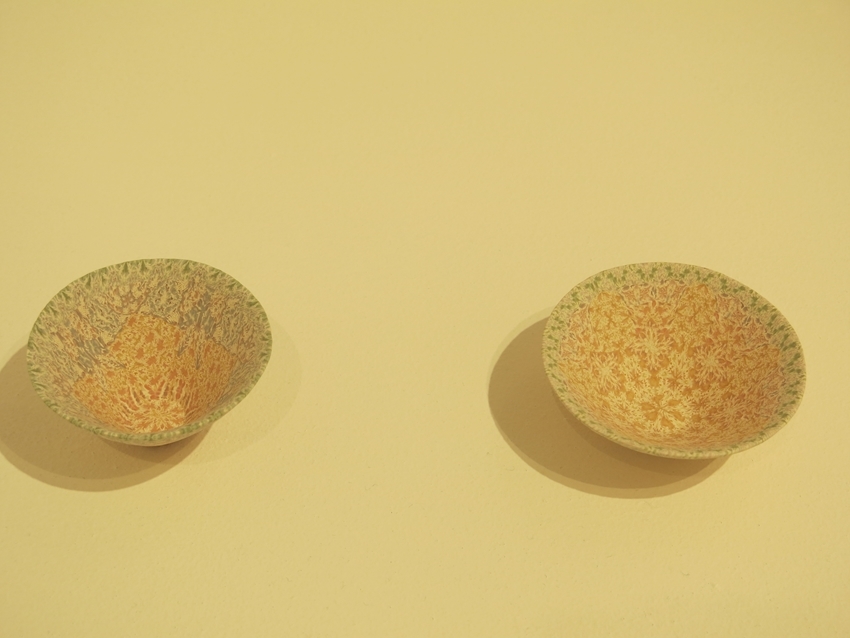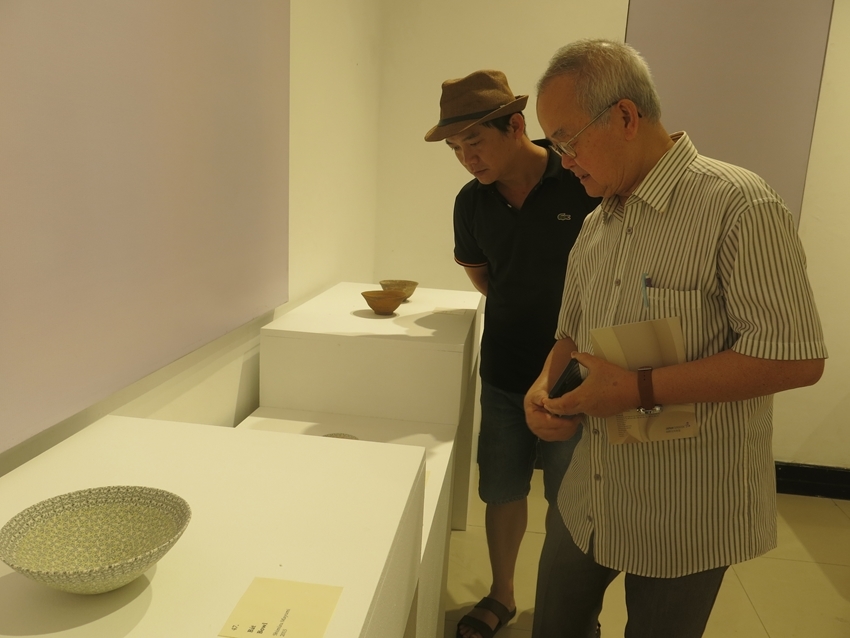    |
 |
| The exhibition attracts the attention of the public |
Rustic and sophisticated objects
With “Yakishime - Shape of the Earth”, many people marveled at the exquisite products of Japanese ceramics, from tea sets to dining utensils, including the even, beautiful and sophisticated, but simple and elegant works of art.
“Japanese pottery is famous all over the world, and with first-hand look, I have really nothing to criticize. Not shiny and brilliant, Japanese ceramics are beautiful, rustic, and delicate from designs to colors and vignettes,” said Ms. Huyen, a resident of Hue City.
The exhibition showcases more than 80 yakishime ceramic works from the earliest examples to contemporary works, including tea utensils used in the tea ceremony, dining utensils and a variety of art works crafted by various pottery artists with the yakishime method.
Tea utensils used in the tea ceremony are cultural features that have an important influence on traditional Japanese culture. During the Muromachi period, with a development of the tea ceremony, tea masters searched for a characteristic Japanese natural feeling, that was expressed through ideas such as wabi and sabi aesthetic standards, and were attracted to yakishime ceramic vases from pottery centers such as Bizen and Shigaraki. They reinterpreted everyday ceramics as vases and fresh water pitchers, then elevated them to tea utensils.
In the exhibition space, tea utensils, including yakishime wares, are displayed as a resemblance of a traditional tea room. Viewers can experience the Japanese tea culture through the yakishime ceramic works that have become recognized tea utensils since the Momoyama period and those of contemporary artists.
    |
 |
| A black rectangular plate made by Isezaki Jun – an artisan and living human treasure |
Dining utensils are also an indispensable part of the daily life of the Japanese. The rustic and luxurious yakishime ceramic bowls and plates of all sizes and colors have contributed to the beauty of Japanese meals.
It is known that, the Japanese food culture of washoku was recognized by UNESCO as an intangible cultural heritage in December 2013. In its statement on washoku, UNESCO claims that a different characteristic of washoku is the perception of the nature beauty and the change of seasons expressed on the table, through the use of dishes and utensils. Various drinks reflect the changing seasons… Such utensils, including yakishime pottery, are not normally used to serve Western food, through which the unique subtlety of the Japanese in their culinary culture shall be perceived.
Today, while continuing to evolve into daily life and tea utensils, yakishime pottery is moving into a new direction as a product of art. Various works of art are crafted by ceramic artists using the yakishime method. The yakishime products have been transformed from the jar and tube forms to many different styles. Some artists are creating yakishime with unglazed porcelain clay, in addition to traditional works.
A long-standing traditional craft of the Japanese people
Yakishime pottery has a history of more than 800 years. Yakishime is a technique of making glazed, unglazed pottery at high temperatures. Despite one of the most basic methods of ceramic production, yakishime has developed in particular directions in Japan.
    |
 |
| The small cups are made very delicately |
The yakishime pottery has been known since the 4th or 5th centuries. However, it was not until the 12th to 17th centuries that the technique gained a firm footing and was used in an important production stage in major ceramic centers in Japan, including Bizen, Shigaraki and Tokoname.
According to creator Mieko Iwai from Panasonic Shiodome Museum - Japan, ceramics are produced all over the world, whether made of ceramic, porcelain or earthenware. However, the Japan's tradition of using unglazed, high-heated yakishime pottery for food and beverage is arguably the most unique.
The yakishime production process is the most basic or primitive method of ceramic production. Many ceramics are glazed for decoration and to create a transparent, waterproof surface. Instead, yakishime pottery is fired at high temperatures so that the clay binds tightly together, vitrifies and waterproofs. The tradition of producing such wares has continued without an interruption from the medieval Japan to the present day.
The production of yakishime pottery began in the late 12th century in Bizen, Tokoname, Shigaraki and other centers of pottery that originated in Sueki, a type of earthenware. During the Momoyama period (1568-1615), yakishime became precious tea making utensils.
Sen Rikyu, the most influential man in the tea world, and Toyotomi Hideyoshi, who unified Japan under his rule, both admired Bizen and Shigaraki yakishime pottery. Under their patronage, many pitchers, tea bowls, tea trays, flower vases and other tea utensils were created.
    |
 |
| A beautiful bowl from its material to patterns that makes viewers admire |
During the same period, yakishime ceramic bowls, plates, pots, and other utensils for serving food and beverage were created for the kaiseki meals that accompanies the tea ceremony. In addition to yakishime ceramic products associated with the form of tube vases, contemporary artists have also created art products using yakishime.
Yakishime pottery has become an integral part of daily life by the Japanese people's long history of unceasingly combining tradition and innovation.
Mr. Doi Katsuma, Director of the Japan Foundation Center for Cultural Exchange in Vietnam shared: “We hope that, through experiencing these rich yakishime ceramic products, the public in Hue city will perceive the depth and diversity of this product, and better understand the creativity of Japanese culture, as well as grasp the delicate traditional craft and unique aesthetics of the Japanese people.”
Dr. Phan Thanh Hai, Director of the Department of Culture and Sports, said that the exhibition taking place during Hue Traditional Craft Festival has a special meaning because the pottery producing itself is also a very famous profession. Like the Japanese, pottery is a familiar object with daily essentials to the Vietnamese. Thereby, we can see many similarities between Vietnam and Japan in dealing with soil to create beautiful products.